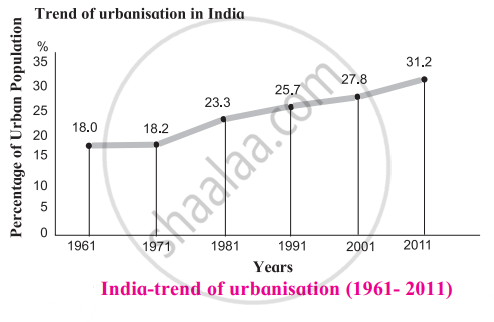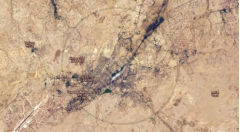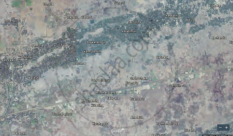Advertisements
Advertisements
प्रश्न
Tell whether settlements shown in images (a) and (b) are urban or rural.
|
(a) |
(b) |
उत्तर
The settlements depicted in both images are rural settlements. Both the areas are depicted as having no proper facilities, building or the skyscrapers of the cities. Both of them are even devoid of proper road facilities.
The area is shown in figure:
(a) is a very interior deserted area. There are no signs of human habitation in the area. The area is shown in figure
(b) has a small patch of greenery in the vicinity. There are few settlements in the area most of them are very scattered. Thus the areas depicted are rural areas that are away from the main cities.
संबंधित प्रश्न
Prepare a multiple bar graph on the basis of the given information and answer the questions.
India and Brazil – Urban population (%)
| Country/ year | 2015 | 2016 | 2017 |
| India | 32.1 | 32.5 | 32.8 |
| Brazil | 84.7 | 84.9 | 85.1 |
1) What is the percentage of urban population in India in 2017?
2) In which country is the percentage of urban population higher?
3) What does the trend in urban population in both the countries indicate?
Answer in detail:
Explain in detail about urbanization in India .
Concentrated settlements are found in Narmada Valley because of ______
Give a geographical reason.
Urbanization is increasing rapidly in India.
Give geographical reason.
Except Delhi and Chandigarh, urbanization is low in other parts of India.
Read the graph in Fig. below and answer the following questions:
- What was the percentage of urbanisation in 1961?
- In which decade was urbanisation the highest?
- In which decade was the growth of urbanisation lowest?
- What inference can you draw regarding India’s urbanisation after reading the graph?
- In which decade is the percentage of urbanization 27.8?
- What is the difference between the percentage of urbanisation from 1971 and 1981?

Prepare a choropleth map showing the urban population using the data given in the table below.
| S.NO | Urban population percentage category | States /UTs falling in the category |
| 1. | 0-20 | Himachal Pradesh, Bihar, Assam, Odisha |
| 2. | 21-40 | Meghalaya, Uttar Pradesh, Arunachal Pradesh, Chhattisgarh, Jharkhand, Rajasthan, Sikkim, Tripura, Jammu & Kashmir, Nagaland, Manipur, Uttarakhand, West Bengal, Andhra Pradesh, Haryana, A & N Islands, Punjab, Karnataka |
| 3. | 41-60 | Gujarat, Maharashtra, Dadra & Nagar Haveli, Kerala, Tamil Nadu, Mizoram |
| 4. | 61-80 | Goa, Puducherry, Daman & Diu, Lakshadweep |
| 5. | 81-100 | Chandigarh, NCT of Delhi |
Prepare a line graph with the help of given statistical information and answer the questions given below-
India-trends of urbanization(%)
| Year | India |
| 1961 | 18.0 |
| 1971 | 18.2 |
| 1981 | 23.3 |
| 1991 | 25.7 |
| 2001 | 27.8 |
| 2011 | 31.2 |
Questions-
- In which year 18% urbanization is found?
- Urbanization has increased by how many percent from 2001 to 2011?
- In which decade was the growth of urbanization highest?
Find the correct pair.
Indian states with less than 61% to 80% urbanisation.
Mark the following in the outline map of India. Write the names and give index:
- Union territory - Daman
- Heavy rainfall region to the west coast
- Cold desert
- Region to the north having high density of population
- Kanyakumari
- Chilka lake


